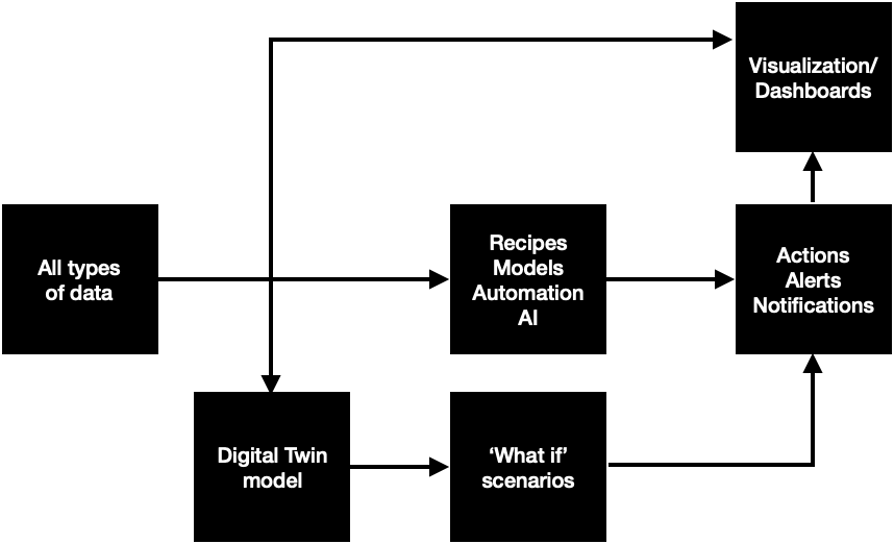
Think Tank
Adding Value to Supply Chain Command Centers

Photo: iStock.com/tujicov
The supply chains that failed during the disruptions of the past several years were decades old, built around domain-specific “control towers.” When first deployed, these data-powered towers enabled a degree of visibility and control across the supply chain. Yet they were focused almost exclusively on the logistics side, and were therefore limited in terms of functionality. They might include internet of things (IoT) sensors on packages, trucks, pallets and other items involved in logistics, but these tools tended to be bespoke, tied to a particular organization, region, or even individual warehouse.
To be sure, problems within the supply chain could be highlighted by a control tower, but it couldn’t fix anything. There was no capability to intervene digitally when things went wrong. That process would have to be elevated and triaged on a case-by-case basis, requiring phone calls, e-mails and manual remediation. When problems were lighting up like Christmas trees during the pandemic, the control tower system ultimately failed.
As a senior pharmaceutical executive recently said, “The problem I have with a control tower is that I can see that there's a problem, but it's like watching a car crash in slow motion: I can't do anything about it. I can only watch it happen.” In the end, he said, it was creating more work and stress.
In With the New
That’s not to say supply chain companies were standing still. Far from it. Customers have always faced supply chain complexities, and technology constantly evolves to address them, bringing advances in key areas such as data science and analytics, rapid communications, packaging and logistics. What the catastrophic failure of supply chains did was place a laser focus on expedited development of powerful, intelligence-driven technologies to remove domain-specific silos, and the need for seamless, real-time digital supply chains to enhance visibility, respond rapidly to changing conditions, and make informed decisions on the fly.
The term “command center” as it relates to supply chain management was coined by Gartner’s Christian Titze and Alexander Hoeppe in a June, 2022 report, “Innovation Insight: Supply Chain Command Centers.” It’s a logical progression from the control tower analogy, conjuring up images of a NASA mission control center, with multiple displays presenting data from myriad sources. In supply chain terms, the command center brings a new level of sophistication and the potential for predictive control that no isolated tower could ever provide.
Beyond Command Centers
The term “supply chain command center” has since entered the mainstream. Almost everybody has an opinion about what a command center is (and isn’t). In discussing the concept, however, it’s important to move from visibility to actionability. Supply chain portfolios must draw on innovations in technologies based on the IoT, digital twins, advanced analytics and decision intelligence.
A command center isn’t merely the deployment of a digital platform that provides consolidated, location-agnostic visibility across all supply chain activities. We have evolved beyond that. Now we’re integrating smart technologies, adding data intelligence and analytics to enable deeper, more informed collaboration. This not only drives proactive, real-time decision making, but makes predictive operations a key element within supply chain operations.
Modern-day supply chains are integrating the capture of any type of signal or application programming interface (API) data, from supply and demand planning, enterprise resource planning (ERP) and operational software. They’re adding signals from the real world, to generate real-time intelligence and context, which is used to take affirmative action. Detailed contextual data, drawn agnostically in near-real-time from any sensor, device, feed, stream or event and fed into a centralized hub, allows users to monitor operations continuously. Should an issue occur, corrective action can be taken immediately to minimize potential impact. Command centers draw on data for connected insights, predictions and the orchestration of processes across functions — including partners and customers throughout the ecosystem.
Integrated Tactical Planning
One key capability that command centers deliver is the migration to integrated tactical planning. ITP combines planning with real-time operations data to make decisions and continuously plan in real time. Prior to the digitization of supply chain operations, the general practice was to plan on a monthly, quarterly or annual basis. Now, manufacturers can plan on a highly granular basis, based on weekly, daily, or hourly needs of the ERP, and transportation-management and warehouse-management systems. With a complete picture of manufacturing, fulfillment and the supply chain, organizations can answer the following questions:
- What inventory is available and where?
- Where are there shifts in demand?
- Which manufacturing lines does it make most sense to use?
- Are there any issues that could inhibit operations?
The Digital Twin
Digital twin technology further enhances command center planning operations, augmenting visibility across the supply chain ecosystem, and supporting analytics, dashboards, scenario analysis and execution. A digital twin is a living model of the entire supply chain that continuously gathers signals from real-time sensors, transactional signals, and contextual real-world data such as traffic, weather, port closures and risk signals. The digital twin extends beyond the four walls of an organization to encompass the entire supply chain. And it’s visible to everyone.
Taking in and analyzing all relevant information, the digital twin can model “what-if” supply chain scenarios. Businesses can envision multiple situations and potential outcomes, and formulate action plans to head off the “butterfly effect” throughout the supply chain. This modeling requires specifying analysis goals and parameters within the digital platform, such as maximizing on time, in full (OTIF), reducing late penalties, improving gross margins, and lowering expedite costs. Once those measures are in place, the platform automates monitoring, analysis and reporting in real time. This intelligence is relayed securely via limited tenants to assigned supply chain constituents, including suppliers and customers, so that they have visibility to shipments and alerts.
Command centers have the capability of being multi-enterprise, adding or removing supply chains through digital-twin modeling. They can embed artificial intelligence for predictive risk mitigation across a wider ecosystem—a key investment priority for organizations. Digital twins can quickly identify potential problems several supply nodes out, and take corrective action in concert with supply chain partners.
The Value of AI
Integrated into a command center, AI models provide the ability for the platform to learn. Taking historic data, machine learning establishes a baseline to which newer data is added to build a contemporary picture. Using AI algorithms, companies can uncover trends and both anticipate and mitigate potential issues. Such models can peer into the future to see where, for example, a manufacturing schedule might need to be updated, because a missing ingredient isn't available in the timeframe within which it’s needed.
AI might advise that, rather than shutting down a manufacturing line or producing a partial run, the better business decision might be to have a supplier send something sooner, or explore other sources. It can actually extend or adjust operations based on business rules and automated decisions that are embedded by the customer. For situations in which ingredients are missing from a nearby warehouse, the organization can direct the AI to alert the procurement team that it needs to expedite shipments of the raw material to keep the manufacturing schedule the way it is. In other cases, the AI could be directed to make adjustments on its own without having to notify anybody. In the process, supply chains can become self-learning, building on base data and adding to it via a feedback loop.
Recipes for Success
Adding all this intelligence and advanced functionality to a command center is built on recipes. There has to be a start point in all data science, which in this case are the recipes developed by the platform provider or by customers themselves, based on criteria for alerts, dashboards, AI engines, modeling, execution actions to software systems, updates to planning systems, and pretty much anything else related to sending or receiving data.
Executed correctly, recipes deliver numerous benefits that improve efficiency, such as the simple automation of alerts and notifications to ensure that they go to the right user in the ecosystem, instead of to a generic supply chain manager. Imagine a scenario where a truck containing temperature-sensitive products is sitting in 100-degree heat. Recipes can be set up to ensure that alerts go to the traffic or transportation manager and trucking company, advising that the truck or its cargo need to be moved to a cooler temperature. Or, in the case of a raw-material shortage at one manufacturer, the system can automatically send the remaining orders to another. Not all disruptions or excursion would be automated, of course, but automating the ones that can be predicted and resolved with minimal effect, with alerts routed to the proper user, adds tangible value.
Figure 1 shows a basic flow configuration, where an AI engine is embedded into recipes to provide recommendations, alerts or actions.

In this diagram, the main input is data from real-time sensors, planning forecasts, production, logistics, demand, estimated time of arrival, weather, traffic, news and so on — all data that’s essential to analyzing the supply chain. This data is used to provide visualization or real-time dashboards to users for analysis. It’s also sent to a digital twin, which can use it for “what-if” scenario modeling. A third use of the data is the creation of recipes, models, automation and AI recommendations. Outcomes of recipes can be as simple as an alert sent to customer service and logistics that a shipment is delayed, or as sophisticated as an AI engine taking into account gross margin, costs, multiple scenarios, traffic and weather, and available transportation options. Recipes can also be in the form of automation, workflows or AI, to automatically change production for a specific product, or reroute a shipment around a storm.
Supply chain command centers herald a new paradigm in supply chain technology, moving organizations from legacy siloed control towers to a centralized, unified and highly engaged platform. Key benefits include increased gross margin, optimized inventory, minimization of disruptions, assurance of quality and compliance, and transparency to customers.
Alok Bhanot is chief technology officer with ParkourSC.






